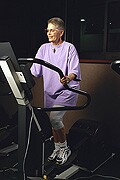Computer Program Helps COPD Patients Monitor Breathing
It helped to reduce air trapped in the lungs during exercise, researchers find
|
E-mail this article
Subscribe to news
Printer friendly version
|

(SOURCE: American Thoracic Society, news release, April 15, 2008)
FRIDAY, April 18 (HealthDay News) -- A computer program may help people with chronic obstructive pulmonary disease (COPD) gain better control over their breathing and breathe more efficiently, according to U.S. researchers who are developing the program.
"COPD is a double-edged sword: The incapacitating lung condition can cause such serious shortness of breath that everyday physical activity, such as walking a flight of stairs, becomes unduly burdensome -- and yet one of the few effective symptomatic treatments for COPD is the very thing that its victims dread most -- exercise," lead researcher Eileen G. Collins, of the Edward Hines Jr. VA Hospital in Hines, Ill., said in a prepared statement.
"One of the key mechanisms of shortness of breath and exercise impairment in these patients is their inability to fully exhale air when active," which causes trapping of the air in lungs (dynamic hyperinflation) and reduces breathing efficiency.
In a new study, Collins and her colleagues tested whether a computer program they're developing could reduce the amount of air trapping during exercise among COPD patients.
"Our primary goal was to determine if patients with COPD would achieve longer exercise duration if they were engaged in ventilation feedback, in addition to the regular exercise program over either ventilation feedback or exercise alone," Collins said.
The 64 patients in the study were divided into three groups: exercise only; exercise plus ventilation feedback (VF); or VF alone. Patients doing VF had their breathing monitored by a computer program that provided them with real-time biofeedback and set individualized goals, which were displayed on a computer screen. Patients could see their current speed and depth of breathing in relation to their set goal and respond by inhaling more slowly and exhaling more completely in order to reach that target.
Patients in the exercise/VF group showed significant improvements in exercise duration, and those in the exercise only group did much better than those in the VF only group. Patients in the exercise/VF group showed a greater reduction in exercise-induced hyperinflation than patients in the other two groups.
The study was published in the April 15 issue of the American Journal of Respiratory and Critical Care Medicine.
If COPD patients can be taught to use the computer program-associated breathing techniques while they do normal daily activities, they may be able to greatly improve their quality of life, Collins said.
More information
The American Academy of Family Physicians has more about COPD. 
Copyright © 2008 ScoutNews, LLC. All rights reserved. 
HealthDayNews articles are derived from various sources and do not reflect federal policy. healthfinder.gov does not endorse opinions, products, or services that may appear in news stories. For more information on health topics in the news, visit the healthfinder.gov health library.